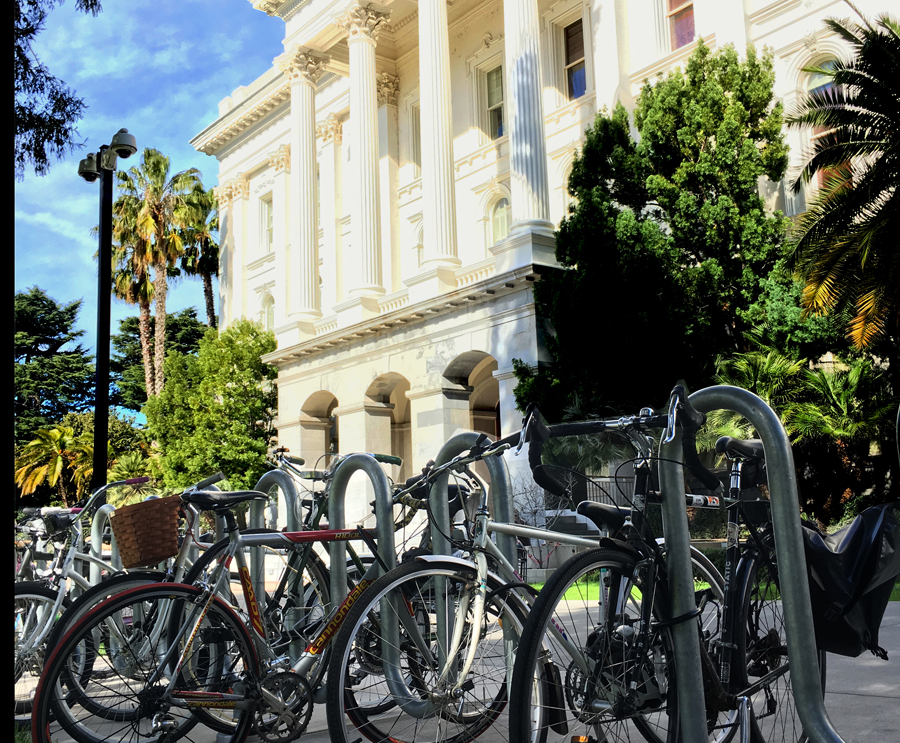Governor Brown is pushing hard to pass two bills that would reauthorize California's cap-and-trade system, telling the Sacramento Bee that to lose would be a tragedy “for California and for the world.”
But proponents of strong climate change policies say that the way one of the bills is currently written could seriously undermine those efforts. A.B. 398 was amended late Monday after several weeks of negotiations, and the plan had been to vote on it as early as tomorrow. But this afternoon, legislative leaders announced that vote would be put off until Monday.
One reason, said their statement, would be “to allow our discussion on long-term housing affordability solutions in California to catch up to the climate effort.”
It's not clear whether that has to do with a list included in A.B. 398 that seems to specifically exclude affordable housing from the priorities for investment from cap-and-trade money.
Governor Brown, Senate President Pro Tem Kevin de Leon and Assembly Speaker Anthony Rendon have called for support of the package, touting California's global leadership and the “strong air quality provisions” of the bills. But critics say that one of the bills' provisions, prohibiting local air districts from imposing certain emission restrictions, is overly broad, and would break promises made by legislators to focus on environmental justice, especially in California's most vulnerable communities.
Brown dismissed criticism of the legislation, telling the Sacramento Bee: “I am really tired of these people peddling their propaganda.”
But the rush to get these bills passed quickly may have as much to do with politics--Brown wants them to pass with a two-thirds vote, to make sure they are safe from legal challenge—as with the urgency of climate change itself.
The current cap-and-trade system is in place until 2020. The Air Resources Board must update is scoping plan for how to achieve its targets by August, but that is a separate process. Indeed, that updating has been ongoing for more than a year and has been hampered by uncertainty about what shape, if any, cap-and-trade would take after 2020.
That process has also involved meetings with “stakeholders” including industries subject to the cap and communities affected by the pollution emitted by those industries. Community advocates have said that the cap-and-trade system is not working as intended, and in some cases has created incentives for industry to increase local pollution that affects vulnerable communities in California. They have pushed for replacing cap-and-trade with regulations that would limit emissions and not allow industries to buy their way out of changing their practices.
On the other side, industry representatives have been pushing for an extension of cap-and-trade as a “market mechanism” they can work with, as long as its restrictions on emissions are not too tight.
“The desperate need to reauthorize cap-and-trade makes no sense,” said Martha Arguello, a member of the Air Resources Board's Environmental Justice Committee. “Because the current system is not giving us the greenhouse gas reductions that we need.”
“The real sense of urgency is in how fast we need to reduce emissions. We are just not reducing them fast enough. Is this bill better than nothing? That may be irrelevant. The point is, it's not good enough. We could do better.”
The EJ committee, said Arguello, held many community meetings to find out what concerns people had. “We listened to people, and the public wants to limit offsets,” she said. “We keep giving regulatory offramps to the oil industry, but it's too late for that.”
“It is disingenuous to talk about the urgency to act on climate change, and at the same time rush through a bill that will impede our ability to fight greenhouse gas emissions,” she said. “There is no reason to force the EJ community to make these kinds of tough choices.”
A letter sent to the governor's office in June [PDF], signed by fifteen assemblymembers, outlined several principles that need to underpin any discussion on extending cap-and-trade. They include:
- Cap and trade must support improving air quality —not just greenhouse gas emissions, which Republican legislators have insisted upon
- Offsets that allow industry to buy their way out of reducing their own emissions should be limited
- The authority of the ARB and air districts must be preserved
None of these principles seem to have made it into the current bills under discussion.






